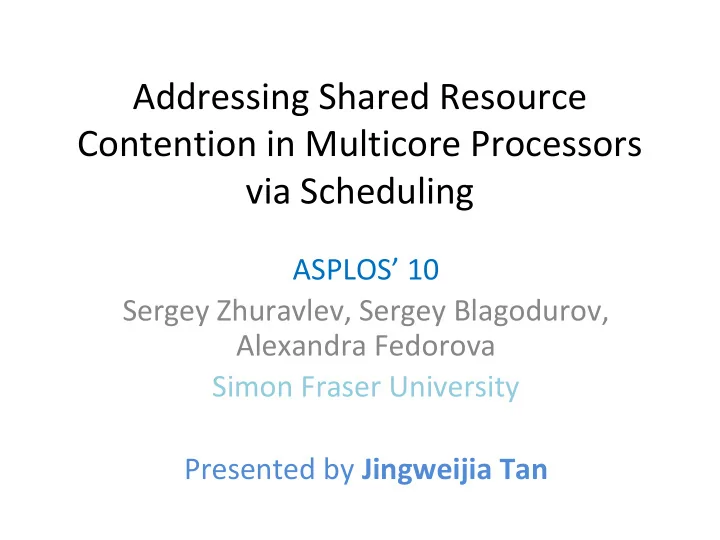

Addressing Shared Resource Contention in Multicore Processors via Scheduling ASPLOS’ 10 Sergey Zhuravlev, Sergey Blagodurov, Alexandra Fedorova Simon Fraser University Presented by Jingweijia Tan
Introduction • Multicore processors become prevalent. • Shared resource contention remains an unsolved problem in existing OS scheduling. – Load balancing • Previous solutions focuses primarily on cache contention. – Not the dominant cause of performance degradation
Goal • Investigate contention-aware scheduling techniques to mitigate performance degradation due to shared resource contention. – classification scheme – Scheduling policy
Contributions • Analyze the effectiveness of various classification schemes • Discover a classification scheme that addresses resource contention – Including cache space, memory controller, memory bus, and prefetching hardware. • Design a new scheduling algorithm
Classification Schemes • A “perfect scheduling policy” [Jiang, PACT’08] – Uses the co-run degradations to construct a graph theoretic representation of the problem, where threads are represented as nodes connected by edges, and the weights of the edges are given by the sum of the mutual co-run degradations between the two threads. – The optimal scheduling assignment can be found by solving a min-weight perfect matching problem.
Classification Schemes • A “perfect scheduling policy” [Jiang, PACT’08]
Classification Schemes • SDC [Chandra, HPCA’05] – Model how two applications compete for the LRU position and estimate the extra misses. – The sum of the extra misses from the co-runners is the proxy for the performance degradation of this con-schedule – Construct a new stack distance profile that merges individual stack distance profiles of threads that run together.
Classification Schemes • Animal Classes [Xie, ISCA’08] – Classify applications’ influence on each other when co-scheduled. – 4 different classes: turtle, sheep, rabbit, and devil. • Miss Rate [Knauerhase, IEEE Micro’08]
Classification Schemes • Pain – Cache sensitivity, cache intensity – Sensitivity: how much an application will suffer when cache space is taken away due to contention – Intensity: how much an application will hurt others by taking away their apace in a shared cache
Classification Schemes Evaluation
Factors Causing Performance Degradation • FSB: front-side bus
Scheduling Algorithms • A combination of a classification scheme and a scheduling policy • Classification scheme: Miss Rate – Easy to obtain online • Scheduling policy: Centralized Sort – Sort applications’ miss rates, and distributes them across cores, such that the total miss rate of all threads sharing a cache is equalized across all caches
Scheduling Algorithms • Distributed Intensity (DI) – all threads are assigned a value which is their solo miss rate as determined from the stack distance profile. – The goal is then to distribute the threads across caches such that the miss rates are distributed as evenly as possible. • Distributed Intensity Online (DIO) – obtains the miss rates of applications dynamically online via performance counters
Evaluation Platform • Dell-Poweredge-2950 (Intel Xeon X5365) – eight cores placed on four chips – Each chip has a 4MB 16-way L2 cache shared by its two cores • Dell-Poweredge-R805 (AMD Opteron 2350 Barcelona) – eight cores placed on two chips – Each chip has a 2MB 32-way L3 cache shared by its four cores
Workloads • 14 benchmarks from SPEC CPU 2006 suite
Results • Intel Xeon 4 cores • DI and DIO perform better than RANDOM and are within 2% of OPTIMAL
Results • Intel Xeon 8 cores
Results • AMD Opteron 8 cores
Discussion • The classification scheme based on miss rates effectively reduces contention for shared resources using a scheduling approach • An algorithm based on this classification scheme can be effectively implemented online (DIO) • Using contention-aware scheduling can help improve overall system efficiency
Related Work • Utility Cache Partitioning [Qureshi, MICRO’06] – Hardware based cache partition – estimates each application’s number of hits and misses for all possible number of ways allocated to the application – partition so as to minimize the number of cache misses for the co-running applications • Cache Page Coloring [Tam, ASPLOS’09] – Software based cache partition – Each application is reserved a portion of the cache, and the physical memory is allocated such that the application’s cache lines map only into that reserved portion. – The size of the allocated cache portion is determined based on the marginal utility of allocating additional cache lines for that application.
Conclusions • Identified factors other than cache space contention which cause performance degradation • Predicted that in order to alleviate these factors it was necessary to minimize the total number of misses issued from each cache. • Developed scheduling algorithms DI and DIO that distribute threads such that the miss rate is evenly distributed among the caches
Recommend
More recommend